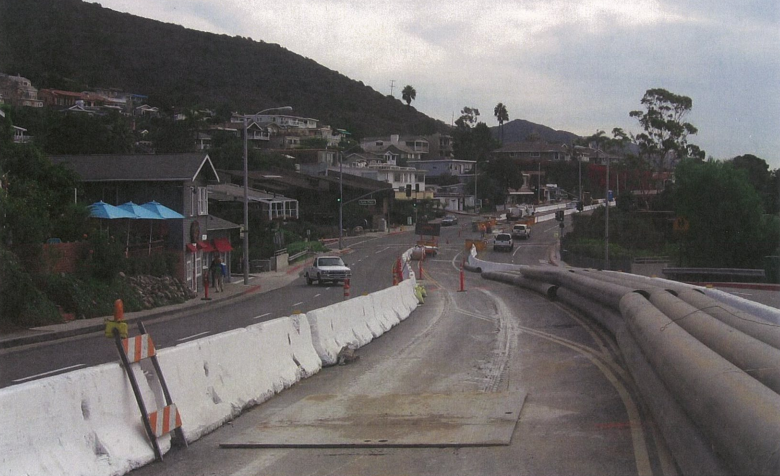
By Bradley Zint, Special to the Independent
Correction: An earlier version of this story misstated the council’s direction. The status of a previous sewage rate increase has been clarified.
A sewage spill that occurred a day before Thanksgiving last year prompted the Laguna Beach City Council to move forward with a one-time sewer rate increase Tuesday that will account for the financial fallout.
Pending the result of a protest vote by ratepayers, the 10% increase ups bills for single-family homes to $800 annually, or $66.67 per month. The hike could take effect as early as July 1.
The proposed increase would replace a series of 6% increases approved last year that was scheduled to last through fiscal year 2024. Instead, the council members will revisit the matter next year following negotiations with state water quality regulators and additional review of the wastewater system’s reliability.
The underlying sewage spill was first detected around 11:30 a.m. Nov. 27, near Ben Brown’s Golf Course. Crews came within two hours, but the raw sewage gush was not fully stopped until nearly 48 hours later.
The general location of the spill was about 2,600 feet downstream from the Coastal Treatment Plant between the canyon wall and a golf course maintenance path. The breaking point was a corroded section of a 3-inch diameter pipe installed around 1989 inside a vault providing service access to the interceptor pipeline.
The incident spilled an estimated 1.7 million gallons, less than half the four million gallons initially reported last year. It also closed a portion of the O.C. coastline between San Clemente and Newport Beach through Dec. 2.
Laguna Beach submitted an in-depth report last month to state water quality officials on the Thanksgiving weekend sewage spill, saying the area’s terrain and lack of cell service hampered the emergency response. Among the other challenges that worked against the spill response team’s effort in November were the spill’s remote location, the lack of “true roads” to support heavy equipment traffic, concerns about flooding and worker safety, and the “extreme difficulty” in locating available workers, supplies, and equipment on a holiday.
Since the incident, city officials have been completing biological and environmental impact analyses. They have also engaged a special legal counsel to handle possible fines.
The San Diego Regional Water Quality Control Board could fine Laguna Beach between $1 million and $3 million, based on policies adopted in 2017, according to a city staff report.
When asked why Laguna Beach’s sewer rates are among the highest in the region, Water Quality Director David Shissler said it’s because the city’s wastewater system is among the most complex in California.
Laguna Beach has hilly terrain, with some stations using the power of gravity to move sewage and others having to move it through pressurized pipes. Laguna uses 25 lift stations, a high amount for only 24,000 users, Shissler said.
Resident Mike Morris expressed dismay that City Hall has the power to levy higher rates in this kind of scenario, instead of only relying on money set aside for it in the budget.
Morris said the rate will likely affect seniors with less money.
“This is always an off-budget item that you can add to everyone’s property taxes as an extra fee,” he added.
In a letter to council members, South Laguna Civic Association President Greg O’Loughlin wrote that the sewage spill in South Laguna’s watershed and marine environments is an alarming reminder of the City’s need to modernize its wastewater system.
“Ultimately, it is the citizens of Laguna Beach who are responsible for the condition of the City’s wastewater system and local ocean water quality as a key resource impacted by our infrastructure and facilities,” O’Loughlin wrote. “South Laguna citizens and coastal marine life and popular recreation areas are most at risk from today’s secondary sewage wastewater discharges.”
Reporting for this story was contributed by Daniel Langhorne.





Correction:
Having read the final, binding Technical Report (TR) delivered to the SD Regional Board 45 days after the dual spills (there were 2 locations, not one as many are unaware of), submitted post TR formal comments to the Board staff, and having dialogued the contents of this column post, CLEAN WATER NOW would submit several corrections:
They have NOT finished their investigation nor have proposed an Assessed Civil Liability amount range—so the City’s allegation of a fine between $1—3 million is precipitous, jumping the gun.
There were 2 distinct locations, 2 separate spill discharges totaling 1.87 million gallons. The City claims that 1.5 mg was barfed @ the Resort golf course, another 387,000 gallons puked @ Bluebird (this relieved pressure on the line to allow repairs). And it took 2 days regardless, fines also carry a per day/per incident/location assessment schedule.
SD staff is still peer reviewing the actual total amount.
As for the SLCA statement, this wasn’t secondary treated wastewater. It was RAW, untreated, unfiltered sewage.
And it is the Council leadership, not the residents/citizens of this berg who have haven’t learned, refused to earmark significant funds to prevent this and other massive prior spills. Even litigation 5 years ago didn’t teach them anything. The City Manager’s go-to device is a bandaid approach, only fix things as they go broken, nothing proactive.
It’s obvious that HE, not the Council who runs this place, they relegate, but the fiduciary buck, accountability/responsibility should stop with all of them. Time to completely overhaul the system and while we’re at it clean house at the CM’s office and Water Quality Department. Overpaid and incompetent.
The spill occurred 2600 feet downstream of the Coastal Treatment Plant (CTP). In 2014 the sludge force main from CTP to the Regional Treatment Plant (RTP) was bid to be replaced, the city’s contribution for this work was $1.4 Million. Why did a failure in 2019 occur in the same force-main replaced in 2014-15? Our water district capital improvement plan should explain the service life for all of Laguna’s wastewater system, it’s time to peel that onion.